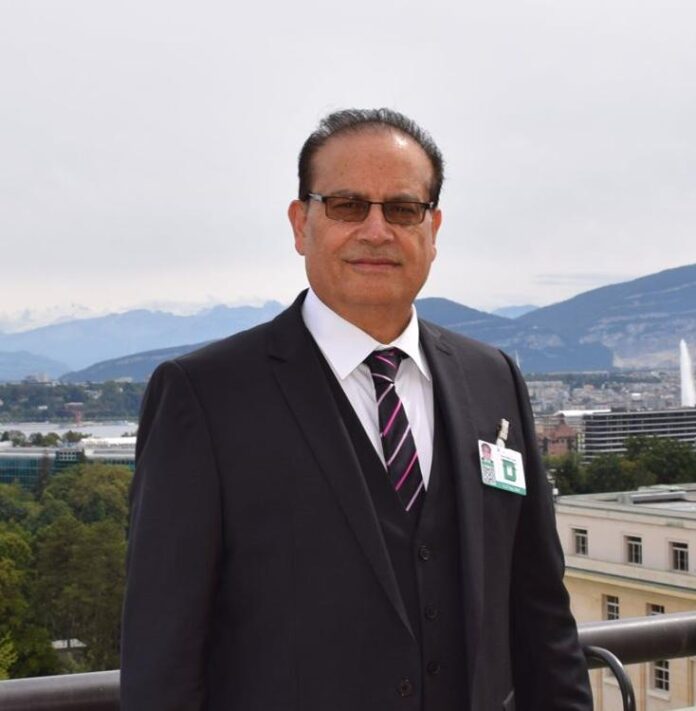By Qamar Bashir
When Donald Trump returned to power in January 2025, he came as a man on a mission — a self-proclaimed savior who promised to restore America’s greatness by reversing what he called decades of “plunder” by foreign nations and betrayal by domestic elites. His message was sharp, emotional, and divisive: America had been looted by others, invaded by outsiders, and weakened by globalists. His rallying cry — “Stop the plunder, make America win again” — became the cornerstone of his campaign and the moral justification for his economic, immigration, and security agenda.
But ten months into his presidency, that crusade appears to have collapsed under its own contradictions. His main policy weapon, tariffs, has crippled rather than strengthened the U.S. economy. His promise to expel immigrants and Chinese students has triggered outrage, legal challenges, and civil unrest. His use of National Guards to quell protests and enforce federal directives has been condemned by constitutional scholars as authoritarian overreach. And his deliberate targeting of Democratic-governed states with funding cuts, while rewarding Republican ones, has deepened America’s internal divide. The second Trump presidency, which began with boasts of discipline and destiny, now stands mired in disorder and disbelief.
Trump’s signature economic doctrine rested on tariffs — sweeping, unilateral duties imposed on nearly every country trading with the United States. On April 5, 2025, he invoked the International Emergency Economic Powers Act (IEEPA) to impose a 10 percent baseline tariff on virtually all imports, rising to punitive levels against countries with trade surpluses. His justification was moral as much as economic: America, he said, had been “robbed blind,” and now it was time to make offenders pay.
By July, the Institute for International Economics reported that the U.S. Treasury had collected $122 billion in new tariffs, with projections of $300 billion by year’s end. The administration celebrated the figure as proof of success. Yet, beneath the headlines, economists saw a darker reality. According to Yale’s Budget Lab, the average American household lost $3,800 in purchasing power due to higher consumer prices, while corporations suffered $34 billion in combined cost increases and sales losses. Imported machinery, metals, electronics, and everyday goods became more expensive; factories dependent on foreign parts slowed or shut down.
Meanwhile, trading partners retaliated. China imposed reciprocal duties and restricted exports of rare-earth minerals, choking U.S. semiconductor and electric-vehicle production. Canada, long the closest ally, saw its aluminum and energy exports to the U.S. plunge by 40 percent. The European Union, facing tariffs averaging 20 percent, redirected nearly $75 billion in trade toward Asia and Africa. India, another supposed ally, tightened its own import barriers, favoring European suppliers over American ones.
By late 2025, the United States had collected roughly $300 billion in tariffs but lost more than $600 billion in trade, investment, and consumer wealth — a net loss twice as large as its revenue. Exporters saw foreign markets evaporate; inflation returned; industrial confidence plunged. The “tariff revolution” that promised to rebuild America instead produced higher prices, weaker factories, and broken partnerships. The very slogan that won Trump re-election — “America First” — had turned into America alone.
In October 2025, a federal appeals court ruled that large portions of Trump’s tariff regime violated constitutional limits under the IEEPA. The case, now before the Supreme Court, threatens to nullify the program entirely. If upheld, the ruling could force Washington to refund up to $1 trillion in illegally collected tariffs to importers and foreign companies — turning a perceived fiscal victory into a staggering liability.
Abroad, allies have grown disillusioned. Canada, once America’s most dependable partner, has frozen joint energy projects and suspended several defense procurement agreements. The European Union has accelerated plans for “strategic autonomy” — reducing reliance on U.S. markets and military backing. Even India, which Trump once courted as a counterweight to China, has shifted toward a more balanced, non-aligned stance. The geopolitical cost of Trump’s tariff crusade may, in time, exceed its economic toll.
While the tariff policy faltered on the global front, Trump’s domestic agenda ignited turmoil at home. His pre-election vow to expel Chinese students from American universities and remove undocumented immigrants from the United States ran into fierce institutional and popular resistance. University presidents, state governors, and business leaders across the country denounced the policy as self-destructive, depriving the nation of talent and labor. Mass arrests by Immigration and Customs Enforcement (ICE) — often televised and heavy-handed — shocked the public conscience.
Detention centers overflowed; protests erupted in California, Illinois, Michigan, and New York; and civil-rights groups accused the administration of orchestrating what they called “state-sponsored social division.” Even Republican mayors in Texas and Florida warned that the crackdown had disrupted local economies dependent on migrant workers. The plan to “secure America’s borders” has instead fractured its communities, producing social tension, moral outrage, and economic stagnation in key industries like agriculture, construction, and services.
Adding to the domestic crisis was Trump’s repeated deployment of the National Guard in Democrat-led states, ostensibly to maintain order amid protests and labor unrest. Governors and constitutional lawyers called it an unprecedented intrusion into state sovereignty. Several state legislatures passed resolutions condemning the federal overreach, while civil-liberties groups filed lawsuits accusing the administration of violating the Posse Comitatus Act.
Simultaneously, the White House began punishing Democratic states by withholding federal infrastructure funds while granting bonuses and subsidies to Republican-governed regions. This selective disbursement of national resources has widened America’s internal divide, transforming fiscal policy into a partisan weapon. The attempt to project strength has instead exposed weakness — a federal government at war with its own states.
Ten months into Trump’s second term, nearly every pillar of his campaign stands eroded. The tariffs meant to punish foreign “plunderers” punished American workers and consumers instead. The immigration clampdown intended to restore “law and order” has generated chaos and shame. The National Guard deployments, framed as decisive leadership, now symbolize federal authoritarianism. And the selective funding of states has alienated millions of Americans who feel their taxes are being used to reward political loyalty rather than public need.
The economic cost of the tariffs — roughly $600 billion in losses — combines with the social and political cost of division: a fractured society, disillusioned allies, and a democracy tested at its seams. Even conservative economists concede that the “America First” project has yielded America isolated, economically weaker, and morally diminished.
As 2025 draws to a close, the central question remains: Can a nation become great again by taxing its own people, dividing its own states, and alienating its own allies? The numbers answer before the historians can. America collected $300 billion but lost nearly twice as much in trade, consumer spending, and trust. Its factories are quieter, its allies colder, its campuses emptier.
Donald Trump’s second term began with roaring confidence and ends, barely a year in, with a silent admission: the slogans that once stirred the crowds — Stop the Plunder, Secure the Border, Restore the Greatness — have fallen flat, leaving behind a trail of broken promises and broken partnerships. All those promises that lifted him to power — tariffs, immigration reform, national security, and federal supremacy — have failed to deliver. Now, as the first year of his presidency closes in turmoil and uncertainty, one question looms large over Washington and the world: does Donald Trump still have the legal, moral, and ethical basis to remain in power? That question may, in the end, define not only his legacy but the fate of American democracy itself.
By Qamar Bashir
Press Secretary to the President (Rtd)
Former Press Minister, Embassy of Pakistan to France
Former Press Attaché to Malaysia
Former MD, SRBC | Macomb, Michigan, USA

















